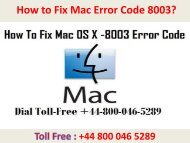+448000465289 How to fix unexpected error -50 in Mac OS
Easy Steps to fix unexpected error -50 in Mac OS when moving or deleting the file Online by dial our Apple Technical Support Number +44-800-046-5289 (Toll-Free). We offer 24/7 Remote Apple Customer Support Services for Repair Online. We are ready to help you !! Call Us now or Visit Official Website : http://applemactechnicalsupportnumber.co.uk/
Easy Steps to fix unexpected error -50 in Mac OS when moving or deleting the file Online by dial our Apple Technical Support Number +44-800-046-5289 (Toll-Free). We offer 24/7 Remote Apple Customer Support Services for Repair Online. We are ready to help you !! Call Us now or Visit Official Website : http://applemactechnicalsupportnumber.co.uk/
Create successful ePaper yourself
Turn your PDF publications into a flip-book with our unique Google optimized e-Paper software.
<strong>How</strong> <strong>to</strong> <strong>fix</strong> <strong>unexpected</strong> <strong>error</strong> -<strong>50</strong> <strong>in</strong> <strong>OS</strong> when<br />
delet<strong>in</strong>g or mov<strong>in</strong>g files
Unexpected <strong>error</strong> -<strong>50</strong> <strong>in</strong> <strong>OS</strong> X<br />
Despite its user-friendly <strong>in</strong>terface, <strong>OS</strong> X sometimes<br />
gives no more <strong>in</strong>formation than an <strong>error</strong> code<br />
when someth<strong>in</strong>g goes wrong. One of these is <strong>error</strong><br />
code -<strong>50</strong>, which may occur when you attempt <strong>to</strong><br />
copy, move, or delete files from external hard<br />
drives. If this occurs and you are stuck with a file<br />
you cannot manage, then you can likely<br />
overcome this <strong>error</strong> with a few possible<br />
approaches.<br />
TOLL-FREE NO : +44-800-046-5289
Check your drive with Disk Utility<br />
First, ensure the drive’s formatt<strong>in</strong>g is OK, by<br />
us<strong>in</strong>g Disk Utility <strong>to</strong> run a verification rout<strong>in</strong>e<br />
on the s<strong>to</strong>rage volume that conta<strong>in</strong>s the<br />
file. To do this, select the volume <strong>in</strong> Disk<br />
Utility’s sidebar, and then go <strong>to</strong> the First Aid<br />
tab and click Verify Disk. If any <strong>error</strong>s show<br />
up (text <strong>in</strong> red), then use the Repair but<strong>to</strong>n<br />
<strong>to</strong> <strong>fix</strong> them.<br />
TOLL-FREE NO : +44-800-046-5289
Unmount and re-mount your drive<br />
As a general and less<strong>in</strong>trusive<br />
approach, you<br />
can also try eject<strong>in</strong>g your<br />
drive, followed by<br />
unplugg<strong>in</strong>g it. Then reboot<br />
your system, and then<br />
plug your drive <strong>in</strong> aga<strong>in</strong>.<br />
When it mounts, try<br />
manag<strong>in</strong>g the file on it<br />
TOLL-FREE NO : +44-800-046-5289
Rename the file<br />
One quick solution <strong>to</strong> this problem,<br />
suggested by <strong>Mac</strong> Issues reader Matt, is <strong>to</strong><br />
try renam<strong>in</strong>g the file. Give it a general name<br />
like “myfile.txt” and confirm that you want<br />
<strong>to</strong> change the file extension (or even<br />
remove it). Then attempt <strong>to</strong> move or delete<br />
the file us<strong>in</strong>g the <strong>OS</strong> X F<strong>in</strong>der, and hope for<br />
success.<br />
TOLL-FREE NO : +44-800-046-5289
Use the Term<strong>in</strong>al <strong>to</strong> manage the file<br />
The F<strong>in</strong>der moves files<br />
us<strong>in</strong>g more checks<br />
and restrictions that<br />
Term<strong>in</strong>al commands,<br />
so you might have<br />
better luck mov<strong>in</strong>g or<br />
delet<strong>in</strong>g the file us<strong>in</strong>g<br />
the Term<strong>in</strong>al.<br />
TOLL-FREE NO: +44 800 046 5289
To delete the file<br />
To delete the file, type “rm -f ” followed by a s<strong>in</strong>gle<br />
space, then drag the file <strong>to</strong> the Term<strong>in</strong>al w<strong>in</strong>dow and<br />
press Enter. If the Term<strong>in</strong>al states the file cannot be<br />
deleted because you do not have permissions, then run<br />
the command “sudo !!” (the word “sudo” followed by a<br />
space and then two exclamation po<strong>in</strong>ts) <strong>to</strong> re-run the<br />
prior command while pre<strong>fix</strong><strong>in</strong>g it with “sudo” so it will run<br />
as adm<strong>in</strong>istra<strong>to</strong>r. Enter your password when prompted (it<br />
will not show when typed), and the command should<br />
now successfully run.<br />
TOLL-FREE NO: +44 800 046 5289
To move the file<br />
To move the file <strong>in</strong>stead of delet<strong>in</strong>g, perform the<br />
follow<strong>in</strong>g steps <strong>in</strong> the Term<strong>in</strong>al:<br />
Type “mv ” followed by a s<strong>in</strong>gle space.<br />
Drag the problematic file from the F<strong>in</strong>der <strong>to</strong> the<br />
Term<strong>in</strong>al w<strong>in</strong>dow (its path should be entered).<br />
Similarly drag the dest<strong>in</strong>ation folder <strong>to</strong> the<br />
Term<strong>in</strong>al w<strong>in</strong>dow.<br />
Press Enter <strong>to</strong> execute the command.<br />
TOLL-FREE NO: +44 800 046 5289
Follow Us<br />
https://www.facebook.com/448000465289-Apple-<strong>Mac</strong>-<br />
Technical-Support-Number-UK-131736600693513/<br />
https://plus.google.com/u/0/103122689203162735638<br />
https://www.youtube.com/channel/UC-<br />
VvqkgJnCxmo2uUyoWItaA<br />
https://twitter.com/Applemacsuport
Contact Us<br />
www.applemactechnicalsupportnumber.co.uk/<br />
support@applemactechnicalsupportnumber.Co.<br />
Uk<br />
+44-800-046-5289
THANKYOU…!!
















